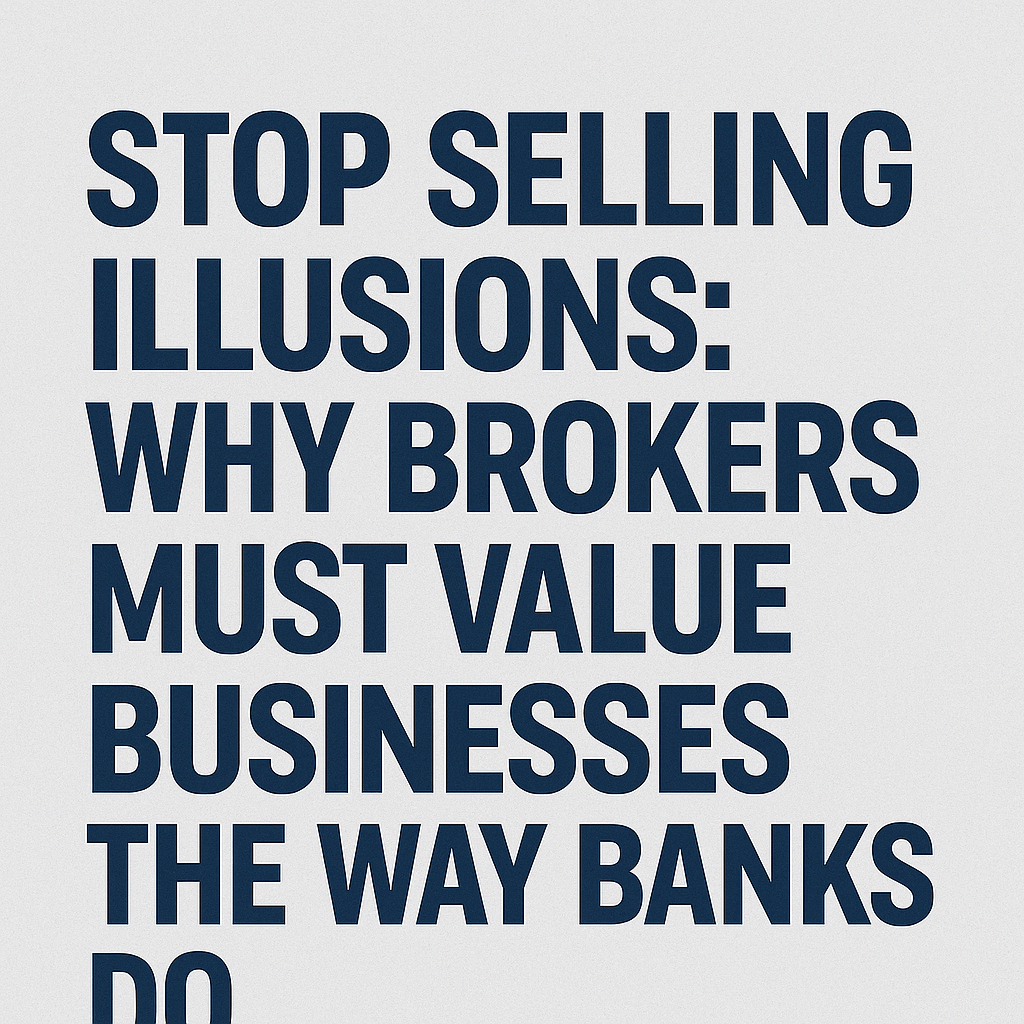
Stop Selling Illusions: Why Brokers Must Value Businesses the Way Banks Do
Stop Selling Illusions: Why Many Business Brokers Misvalue Small Firms (and What They Should Be Doing)
Too many small businesses never sell—not because there’s no demand, but because listing prices are detached from how real buyers—and banks—actually underwrite deals. Brokers pitching high SDE multiples to win mandates may look flashy in an MLS listing, but they’re pitching death by credit desk.

The Myth of SDE: Why It Fails the Bank Test
Seller’s Discretionary Earnings (SDE) is often treated as the golden metric by brokers. It adds back owner salary, perks, nonrecurring expenses, etc., and gives a big, appealing number to the seller. But here’s the trap: SDE assumes the buyer doesn’t have to pay a competitive replacement salary or incur real operating costs that the current owner hides.
-
According to Morgan & Westfield, SDE includes the owner’s compensation as an adjustment—useful in some settings, but misleading if taken too far in pricing. Morgan & Westfield
-
In practice, most brokers push add-backs liberally, often without rigorous scrutiny—a practice that makes financials look friendlier than they really are.
-
Lenders, however, don’t pay for your “funny add-backs.” They lean instead toward EBITDA or adjusted cash flow after replacing the owner with a market wage. (See “SDE vs. EBITDA” from MidStreet) midstreet.com+1
In short: SDE is fine for rough talk, but lousy for bankable deals.
DSCR: The Bank’s Reality Check
Banks (especially those backing SBA deals) don’t care what looks good on an add-back schedule—they care: can this business pay the debt obligations after paying someone to run it? That’s where Debt Service Coverage Ratio (DSCR) comes in.
-
DSCR is defined as cash flow (after necessary operating expenses) divided by annual debt service (principal + interest). Investopedia+1
-
Many SBA lenders require a minimum DSCR of ~1.25× to consider a deal viable. SBA 7(a) Loans+1
-
Some banks may allow DSCR down to 1.15× in certain structuring, but that’s pushing the edge. IBA Business Brokers+1
If your asking price destroys DSCR, no underwriter will let it through—even if your broker’s EBIT add-backs are dazzling.
Who Gets Blamed When Deals Fail? Brokers Like Sunbelt Should Be Called Out
That listing you see for “$1.5M, 3× SDE” may look sexy—but often, underneath is a fragile financial shell. Brokers (including large networks like Sunbelt Business Brokers) have institutional incentives: win the mandate. So they lean hard into inflated valuation models that look good in pitch decks, not audit trails.
Here’s how it usually goes wrong:
-
Seller is led to believe their business is worth X, based on over-optimistic add-backs.
-
Buyer submits offer; lender pulls the financials and strips add-backs, demands market salary, recalculates DSCR.
-
The deal either re-negotiates heavily downward or dies outright. Sellers feel betrayed, buyers get lost in re-trades, trust in the process erodes.
This kind of overpromise, underdeliver is not just sloppy—it’s unprofessional. Brokers should shoulder their share of accountability for the deals that never close.
A Better Way: Valuation Through the Bank’s Lens
If your goal is actually closing deals (not just listing), here’s a valuation framework brokers should adopt:
-
Normalize to EBITDA / adjusted cash flow.
-
Replace owner wages with a market rate salary for a GM/owner role.
-
Only include truly defensible nonrecurring items; avoid speculative or inflated add-backs.
-
-
Run the DSCR test up front.
-
Model various debt scenarios under SBA or conventional terms.
-
See whether the business can deliver ≥1.15–1.25× DSCR after paying that “new” manager.
-
If it fails, lower your price or restructure the financing.
-
-
Price with realistic debt stacks.
-
Assume ~75–80% financed, ~10% buyer equity, ~10–15% seller note (or standby).
-
Don’t list a price that forces exotic structures or hidden contingencies.
-
-
Tie valuation to audited returns.
-
Lenders will default to tax returns and bank statements over broker schedules.
-
Use clean bridges: tax returns → recast → adjusted EBITDA → valuation.
-
-
Communicate the downside openly.
-
Tell sellers: “This price is as high as we expect a lender to accept, but it might need adjustment.”
-
That honesty builds trust and weeds out unrealistic expectations early.
-
Why This Matters (and Who Wins)
-
More listings will actually sell, not sit wasted on the market.
-
Buyers using SBA and other leverage will actually qualify, reducing failed deals.
-
Sellers will trust the process less as a gamble and more as a systems game.
-
Brokers who shift to this discipline attract better buyers, shorten close times, and preserve reputation.
If Sunbelt and peer firms want to stay relevant in a world of credit scrutiny, they can’t keep treating listing price as a marketing prop. They have to act like deal architects, not showmen.
